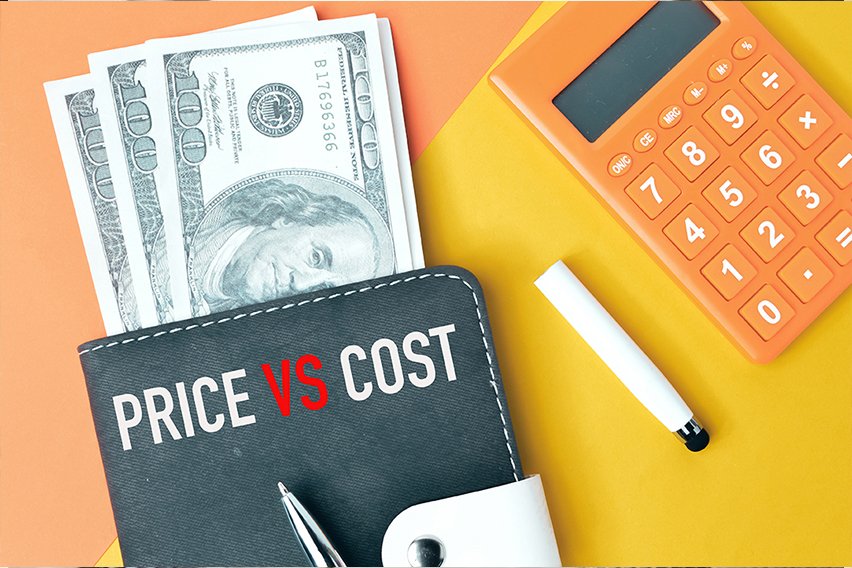Cash Inflow vs Outflow: What’s the Difference?

A better understanding of cash flow will help you navigate your business finances with confidence. This article will give you insight on the differences between cash inflow and cash outflow, and how to manage both for your small business.
This article will cover:
- Business Cash Flow & Why it Matters
- Cash Inflow Defined
- Cash Outflow Defined
- Cash Inflow vs Outflow & How to Calculate It
- Enhancing Your Business Cash Flow
- Understanding the Essentials
Here’s What We’ll Cover:
Business Cash Flow & Why it Matters
Maintain Positive Cash Flow in Your Business
Cash Inflow vs Outflow & How to Calculate It
Compare and Contrast Cash Inflow/Outflow
Enhancing Your Business Cash Flow
Understand the Essentials of Cash Flow Management
Business Cash Flow & Why it Matters
There are many elements that go into managing the books for your business. Navigating your expenses by keeping an account of business cash flows is key to a smooth accounting process. So, what is cash flow?
Cash flow is the total amount of income flowing in and out of your business.
It’s easy to mix up cash flow with profit and working capital, so it’s important to distinguish the difference. Cash flow is the broad term representing the full amount of both income and expenses of your business; so it does not necessarily determine your profit.
Cash flows in and out support three different types of business activities: Operating, Investing, and Financing.

Operating costs
One of the biggest hurdles in keeping a positive cash flow is the costs of keeping operations going. Costly resources such as rent, inventory, and raw material expenses used for operational purposes all add up to eat away at your cash budget.
Investing
An excellent way to keep a positive cash flow for your business is to invest. There are many different types of investment that will benefit your business. Current assets such as intangible assets, stock in legible entities, and future contracts can all be valuable resources to keep a steady and growing cash flow.
Financing
Financing is a broad term that can both help and hurt your business. Wise financing decisions that allow you to invest in better equipment or work with affiliated entities can definitely give your company a leg up. Avoid unnecessary financing activities that may disrupt your flow or set your business back.
When your business is bringing in more profit than it is spending, you have positive cash flows. In contrast, if your business is spending more than your income, you have negative cash flows.
What Affects Cash Flow?
- Operating activities
- Investing
- Financing
- Long-term debt
A positive cash flow keeps your business afloat, managing a positive cash flow will ensure that you’re always earning more than you’re spending.
More than just staying positive, a strong business will have a focus on growing. In order to grow your business, you’ll need cash to reinvest (buying new equipment, advertising costs, investing in new projects), as you cover operating costs and liabilities.
A great way to manage your cash flow is to have accounting frameworks in place that give you clear insight into your cash inflow vs outflow.
Avoiding a negative cash flow will allow you to make wiser business decisions.
Maintain Positive Cash Flow in Your Business
Maintaining a positive cash flow in your small business is essential to gaining profit. Operating expenses, debt payments, and other liabilities all eat into your profits and can add financial strain to your overall cash flow. It takes managing your financial activities in a mindful way to keep a positive cash flow.
To better understand cash flow as a whole, we can break it down to two categories; cash inflow and cash outflow–both play major roles in your balance sheet statement.
Cash Inflow Defined
Cash flow is separated into two essential categories; cash inflow & outflow. Cash inflow sets the rate of business growth– the more cash inflow you have, the better set you are for your business funding.
What is Cash Inflow?
Cash inflow describes all of the income that is brought to your business through its activities– any strategy to bring profits into the business. Maintaining a strong cash inflow will keep your business afloat and allow you to reinvest and grow your business as you cover general expenses.
Cash Inflow Includes:
- Proceeds from sales of goods or services
- Returns on investments
- Financial activities
- Interest built over time periods
Businesses typically make the majority of their cash inflow by selling products or services to customers and clients, invoicing them for the order, and then receiving payment. Growing businesses may also choose to invest in stocks or other companies and gain profits from those investments as well.
All of these activities translate to cash inflow for the business and add to the overall cash balance growth.
Cash Outflow Defined
The more cash inflow that you have, the more resources you have available for your business. Proceeds from sales, positive investments, and profitable financial activities all play a part in growing your cash inflow. In contrast, there are many expenses that deplete your overall cash flow as well.
Operating expenses, debt, and liabilities all play a role in cash outflow.
What is Cash Outflow?
Cash outflow refers to all of the expenses paid out by your business. Cash outflow includes any debts, liabilities, and operating costs– any amount of funds leaving your business. A healthy business maintains a positive cash flow by keeping flows from operating low, and minimizing long-term debts.
Cash Outflows include:
- Operating expenses
- Liabilities
- Debts (long-term debts, reinvestments)
- Annual interest rates
- Wholesale funding
There are many factors that play into cash outflow, and it’s crucial for business owners to keep a detailed financial report to outline contributing factors that play into cash outflow.
Operating expenses take a majority of business profits in order to maintain. Expenses like storage costs, utilities, travel expenses, and rent are all contributing factors in operating activities. Minimizing these expenses will help keep cash outflow low.
Cash Inflow vs Outflow & How to Calculate It
Cash inflow and outflow go hand-in-hand when it comes to your cash flow statement. Keeping a positive cash flow requires proper management of debts, practical financial activities, and a thorough, detailed financial strategy.
Main Differences: Inflow vs Outflow
The difference between cash inflow vs cash outflow is fairly straightforward. Cash inflow is the cash you’re bringing into your business, while cash outflow is the money that’s being distributed by your business.
While distinguishing between the two may be simple, there are elements that make cash inflow and outflow different entities in your cash reserve.
Cash inflow is typically produced by sales and growing investments. If your business is making daily sales, your inflow will be reflecting that. If you’re making long-term investments, that cash inflow may not be seen as often.
In contrast, if you’re making daily sales, you’re also spending money on operating costs and raw materials, which increases your cash outflow.
Regularly documenting your income and your expenses in a financial report will help you stay on top of your flowing cash.
Are We Just Referring to “Cash”?
Your business cash flow highlights all spending types. Yes, it refers to cash transactions, but it also includes many other forms of payment. Anything of value that you’re bringing into or dispersing from your business counts.
What Counts as Cash Flow:
- Actual cash flow (cash proceeds)
- Credit or debit purchases
- Current assets
- Sale of assets
- Dividend payments
What is a Financial Report?
You can calculate your cash flows by keeping a financial report. A financial report is a statement of cash flows for your business.
Key elements of a financial report:
- Cash flow statements
- Operating activities
- Debits & credit reports
- Cash equivalents
- Liabilities
A financial statement outlining your cash flows will act as a balance sheet statement that will help guide you through your business finances and can give you key insight into your spending, and how your operating expenses and other costs are playing into your overall profits. If you’re unsure how to create one, you can refer to our guide on a sample of financial statement to get started.
Each time that you make a sale, gain profit on an investment, or positive interest on financial activity, you can document it in your financial statement. Likewise, you may keep a balance sheet statement with all of your cash outflows documented.
Compare and Contrast Cash Inflow/Outflow
Use your financial statement to compare and contrast your cash inflow vs outflow and better understand your funding availability.
An example of a valuable financial statement is a cash flow statement. In the cash flow statement, financing activities refer to the flow of cash between a business and the investors or creditors. These activities focus on how the business intends to raise capital and pay back its investors.
These activities include:
- Buying and selling stock
- Paying cash dividends
- Adding loans
In a cash flow statement, each time a business has received cash (cash inflow) a positive number on the statement will indicate that transaction, boosting the asset levels. In contrast, a negative figure indicates that the business has made a payout (such as a dividend payment or debt payment).
Cash flow statements help you follow your business cash flows and evaluate if and where you need to make changes to better suit your business growth.
Learn more about cash flow statements.
Enhancing Your Business Cash Flow
A thorough cash flow statement will give you access to the crucial elements of maintaining a positive cash flow, all the while growing your business and gaining insight on your overall expenses and long-term debts.
Your cash flow statement will outline your cash inflow vs outflow and how they compare.
Cash Inflow describes all of the income that is brought to your business through its activities– any strategy to bring profits into the business.
Cash Outflow includes any debts, liabilities, and operating costs– any amount of funds leaving your business.
Tips for Managing Cash Flow
In order to enhance your cash flow and grow your business, you must keep a positive cash flow, by keeping your inflow greater than your outflow.
Ways to do this include managing operating expenses and activities, minimizing debts, and making positive reinvestments– all the while keeping thorough documentation of your financial activities.
To better manage cash flow in your business, you should:
- Maintain a positive cash flow by keeping your cash inflow greater than your outflow
- Keep profits high with quality goods and services
- Invest in advertising strategies
- Invest in profitable stocks and companies
- Invest in quality operating services or equipment that will provide better production
- Minimize operating costs
- Keep financial statements that document profits and expenses
What About Cash Flow Forecasting?
Both cash inflow and outflow are happening in your business simultaneously. If you’re expending cash in your company, whether you’re making daily sales, looking to reinvest, or creating new advertising, you’re spending money. Likewise, these strategies should be boosting your cash inflow by getting you more clients or customers, building connections through investments, and setting you up for future success.
As all of this cash flow is occurring, you need to have a way to document the movement and understand where your spending may need adjustment. There are lots of cash management services that can help you better manage your budget, and you can start by keeping a financial report that outlines your cash flow statement.
Predict Cash Flow Trends
By having a clear and current cash flow statement, you’ll be able to predict trends in your spending and forecast the future of your business. You can also use the statement to reference past sales rates to plan your inventory, and change advertising strategies.
With your cash flow statement, both your cash inflow and outflow will be outlined.
Seeing the fine details of where your profits are coming from and where you’re spending your money with a cash flow statement, you can adjust your financing activities to reserve resources and forecast your future sales.

Understand the Essentials of Cash Flow Management
Cash inflow and outflow make up the vast spectrum of your overall business growth. Keeping a positive cash flow takes making sure that your inflow is more than your outflow, and keeping a steady rise in sales will ensure steady business growth. Keeping track of your overall cash flow will give you insight into your cash inflow vs outflow, and what you can do to manage costs and ensure cash-raising transactions.
Constant consideration of cash inflow vs outflow will keep a strong business on the right trajectory.
Remember that there are so many aspects that play into keeping a positive cash flow and tracking your financing activities over a period of time is your best bet to staying in the loop when it comes to your business transactions.
Key Elements of Cash Inflow:
- Your business cash inflow includes all of the profit that your company makes through selling products, making investments, and other methods of increasing income.
- You can keep your money in the bank by making stable deposits, investing in cash equivalents, and creating additional funding platforms
- Cash Inflow is not the same as profit or capital but both terms are included as cash inflow as they both play a part in gaining income
- Minimizing debts, deprecation, and other sources of negative cash flow will increase inflow and keep a positive balance
- Keeping financing activities documented in a financial report gives you a clear understanding of your accounting activity during a period of time
More Resources on Cash Flow
- What Is Cash Flow? Almost Everything You Need to Know
- What Are Financing Activities?
- How to Read a Financial Report?
Wondering About Working Capital?
RELATED ARTICLES

 What Is ARN Number & How to Track Transactions?
What Is ARN Number & How to Track Transactions? 4 Best Fixed Assets Software for Accounting Management
4 Best Fixed Assets Software for Accounting Management How to Calculate EOQ (Economic Order Quantity)
How to Calculate EOQ (Economic Order Quantity) Small Business Bookkeeping: A Beginner’s Guide (2025)
Small Business Bookkeeping: A Beginner’s Guide (2025) Budgeting vs. Forecasting: What’s the Difference Between the Two?
Budgeting vs. Forecasting: What’s the Difference Between the Two? What is an Undeposited Funds Account? Everything You Need to Know
What is an Undeposited Funds Account? Everything You Need to Know